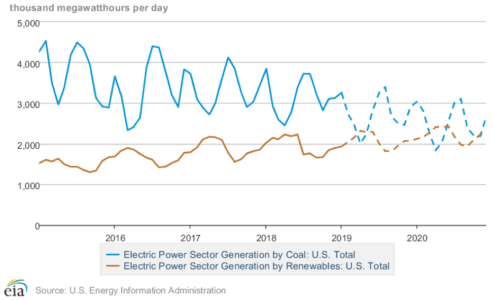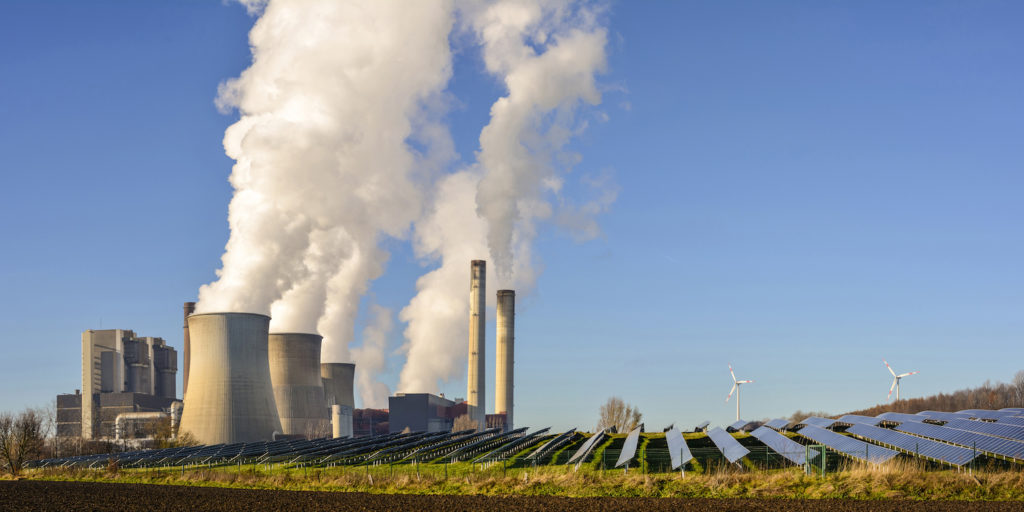From pv magazine USA.
King Coal appears to be dying, and this month will see a new U.S. milestone in the decline of what was the largest source of electricity generation during the 20th century and the early years of the 21st.
According to a study by the Institute for Energy Economics and Financial Analysis (IEEFA), which examined figures from the U.S. Department of Energy’s Energy Information Administration (EIA), renewable energy sources including hydroelectricity are set to generate more power than coal for the first time.
The analysis predicts renewable sources will have generated 2.32 TWh of output this month and will produce a further 2.27 TWh in May. Both figures are ahead of the 2 TWh and 2.24 TWh, respectively, expected to come from coal.

Short and long-term trends
There are two trends behind the crossover and they operate on different timescales. First, as illustrated in the chart above, renewable energy generation always rises in spring, due to a rise in hydroelectric power as rivers swell, including from snow melt. IEEFA notes spring is when many coal plants close for maintenance for that reason, as power prices are at their lowest and they are least likely to be needed.
The longer-term trend is that coal’s share of the U.S. electricity mix is falling, and that fall has been particularly precipitous over the last five years. According to the EIA, coal made up 39% of U.S. electricity generation as recently as 2014, but only 27% last year.
The main driver has been abundant, cheap natural gas due to the rise of hydraulic fracturing – fracking. More electricity has been generated from gas-fired power plants than coal on an annual basis every year since 2015. However, wind and solar capacity is also expanding rapidly, enabling renewables to claim an increasing share of electricity generation. Wind and solar made up 9% of U.S. electricity generation last year, up from only 1.6% in 2008.
Further transition
With no new coal plants being built and gas, wind and solar dominating new electricity generation, there is no end in sight for the decline of coal. In fact the question has not become whether these sources will replace coal but how much gas-fired capacity will be built before gas is eclipsed by renewables, as is already happening in California.
On the national scale, the ageing coal fleet continues to retire. The EIA predicts 7 GW of coal plant capacity will go offline by the end of next year and analysis by Energy Innovation has shown that in 74% of cases it is cheaper to build new wind and solar facilities than to keep running coal assets. That percentage is expected to rise to 86% by 2025.
It will still take a few years for renewables to entirely eclipse coal in the U.S. and in June it is expected coal-fired generation will again surpass renewables.
Until next spring, that is. And some time in the next decade you can expect the lines to cross over entirely.
This content is protected by copyright and may not be reused. If you want to cooperate with us and would like to reuse some of our content, please contact: editors@pv-magazine.com.








By submitting this form you agree to pv magazine using your data for the purposes of publishing your comment.
Your personal data will only be disclosed or otherwise transmitted to third parties for the purposes of spam filtering or if this is necessary for technical maintenance of the website. Any other transfer to third parties will not take place unless this is justified on the basis of applicable data protection regulations or if pv magazine is legally obliged to do so.
You may revoke this consent at any time with effect for the future, in which case your personal data will be deleted immediately. Otherwise, your data will be deleted if pv magazine has processed your request or the purpose of data storage is fulfilled.
Further information on data privacy can be found in our Data Protection Policy.